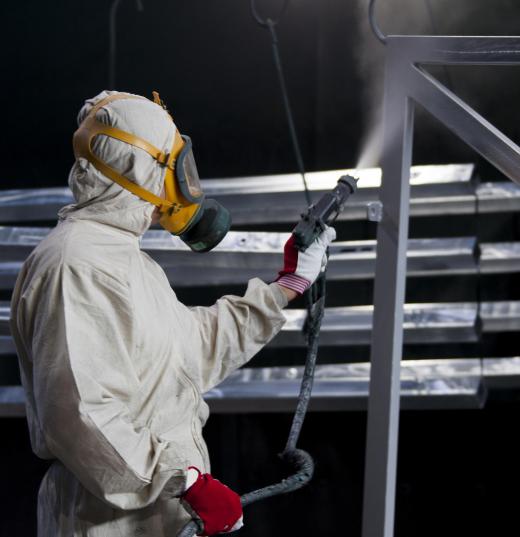A spray paint compressor is simply an air compressor that is attached to a paint sprayer. Many homeowners and paint industry professionals use spray paint compressors to apply large amounts of paint to a big project, such as painting a home's exterior. The forced air from the compressor projects the paint droplets outward into a fine mist for an appealing and long lasting paint job.
Basic air compressors pressurize air through mechanical pistons, creating a smaller volume within the tank. As a result, the pressurized air moves rapidly from the compressor, through attached hosing, and finally into the paint sprayer. Air mixes with the paint and propels out of the paint sprayer's fine tip. Many painters prefer this method of application since it provides a quality paint job in less time, compared to painting with brushes or rollers.

Spray paint compressors are mainly used for large paint projects, as opposed to painting one wall. Smaller spray paint equipment is available in airless choices, using smaller mechanical assemblies for moving paint out of the sprayer instead of forced air. A spray paint compressor can be relatively large, depending on the attached sprayer. Some consumers may find it difficult to move and maneuver a spray paint compressor around a project site.
Painters must match spray paint compressor specifications with the sprayer's abilities. Compressors that offer high air volume may damage the sprayer by forcing too much pressure through the mechanical parts. As a result, the sprayer is damaged internally, producing a poor paint spray. In contrast, reduced air volume through the sprayer will project a weak paint spray, lowering the coat quality against the surface.
Many times, a spray paint compressor can be purchased as a kit with a paint sprayer. The manufacturer will ensure that the compressor and sprayer are compatible. On the other hand, many consumers would like to use the compressor for other uses around the home, such as powering air grinders and sanders. In this case, the consumer would need to match specifications between the compressor and all the tools he or she intends on attaching to the machine.
Newly purchased paint tends to be thick. Often, painters must thin the paint for it to run smoothly through the sprayer; however, a spray paint compressor with high air volume and a strong motor can push thick paint out. Smaller motors and tanks cannot generate the force needed to push thick paint out, so the painter would need to thin the paint before placing it in the sprayer.
